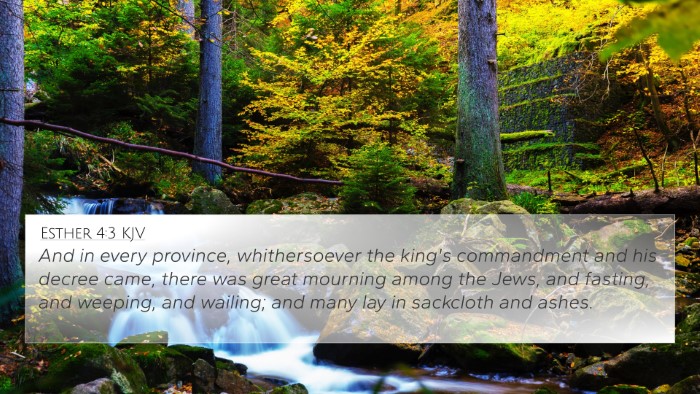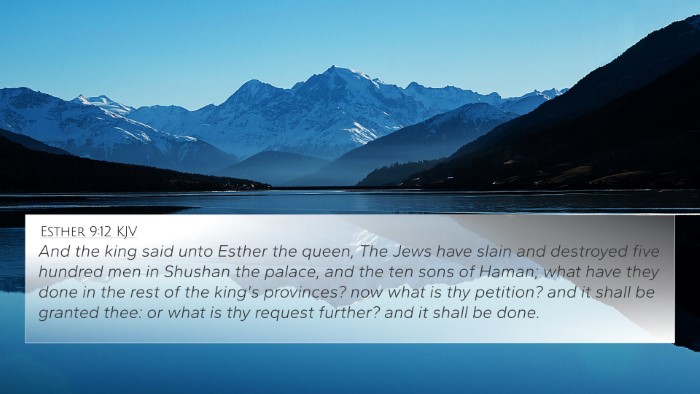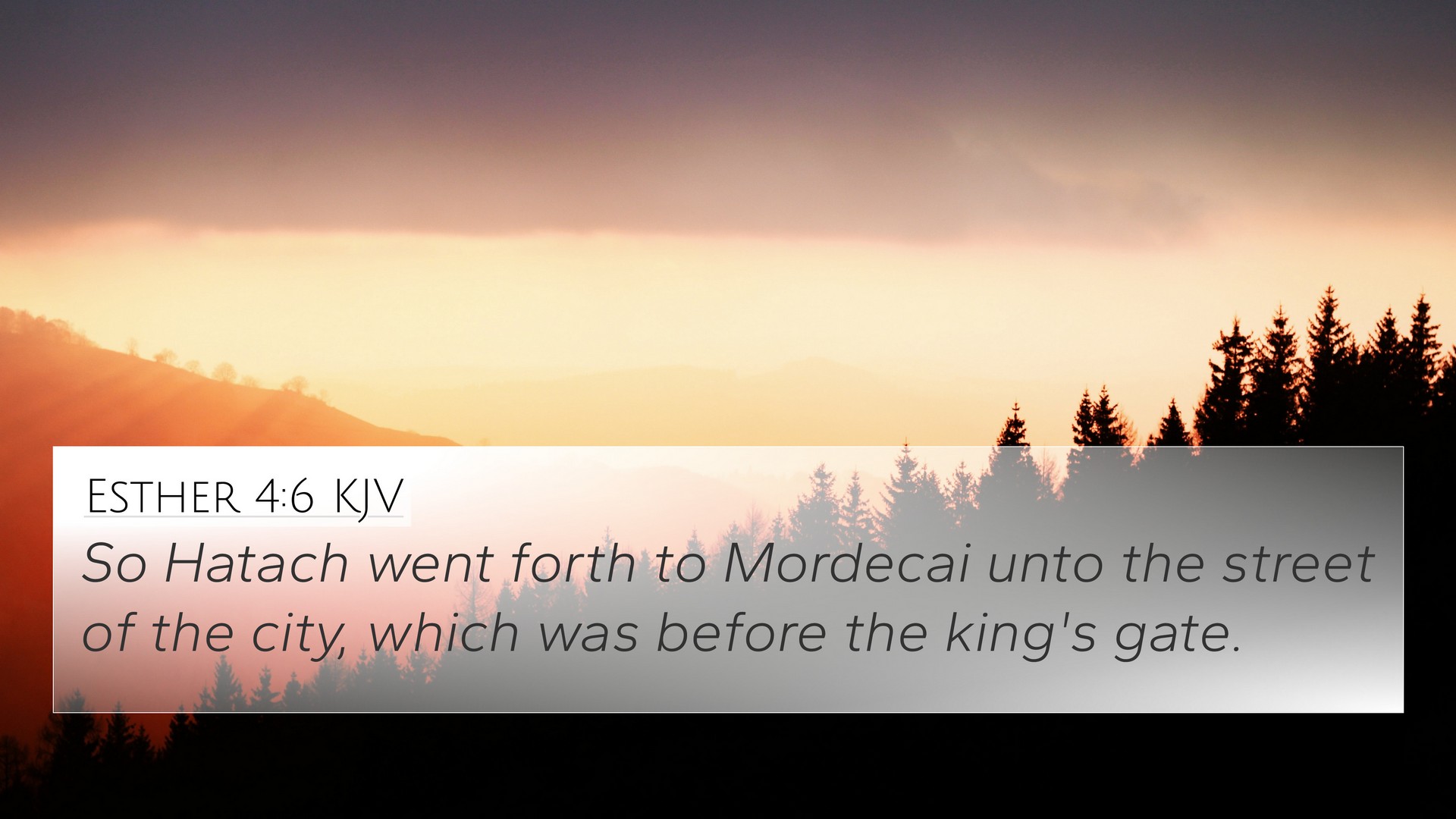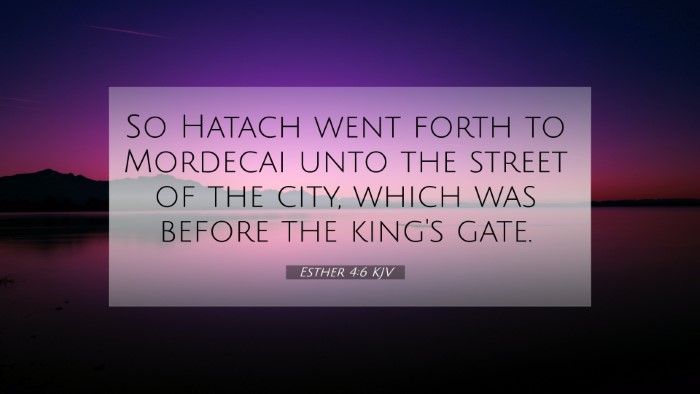Old Testament
Genesis Exodus Leviticus Numbers Deuteronomy Joshua Judges Ruth 1 Samuel 2 Samuel 1 Kings 2 Kings 1 Chronicles 2 Chronicles Ezra Nehemiah Esther Job Psalms Proverbs Ecclesiastes Song of Solomon Isaiah Jeremiah Lamentations Ezekiel Daniel Hosea Joel Amos Obadiah Jonah Micah Nahum Habakkuk Zephaniah Haggai Zechariah MalachiEsther 4:6 Similar Verses
Esther 4:6 Cross References
So Hatach went forth to Mordecai unto the street of the city, which was before the king's gate.
Uncover the Rich Themes and Topics of This Bible Verse
Listed below are the Bible themes associated with Esther 4:6. We invite you to explore each theme to gain deeper insights into the Scriptures.
Esther 4:6 Cross Reference Verses
This section features a detailed cross-reference designed to enrich your understanding of the Scriptures. Below, you will find carefully selected verses that echo the themes and teachings related to Esther 4:6 KJV. Click on any image to explore detailed analyses of related Bible verses and uncover deeper theological insights.

Esther 4:3 (KJV) »
And in every province, whithersoever the king's commandment and his decree came, there was great mourning among the Jews, and fasting, and weeping, and wailing; and many lay in sackcloth and ashes.

Esther 7:2 (KJV) »
And the king said again unto Esther on the second day at the banquet of wine, What is thy petition, queen Esther? and it shall be granted thee: and what is thy request? and it shall be performed, even to the half of the kingdom.

Esther 9:12 (KJV) »
And the king said unto Esther the queen, The Jews have slain and destroyed five hundred men in Shushan the palace, and the ten sons of Haman; what have they done in the rest of the king's provinces? now what is thy petition? and it shall be granted thee: or what is thy request further? and it shall be done.
Esther 4:6 Verse Analysis and Similar Verses
Understanding Esther 4:6
Esther 4:6 states: "So Hathach went in unto Esther, and told her the words of Mordecai." This verse is pivotal in setting the stage for the unfolding events in the book of Esther. Below, we explore its meaning and connections to other biblical texts, drawing insights from respected public domain commentaries.
Verse Meaning and Context
In this particular verse, Hathach, the eunuch assigned to Queen Esther, serves as a messenger. He connects Esther with her cousin Mordecai, who is in distress due to the impending doom facing the Jewish people. This moment showcases the importance of communication and the roles individuals play in God's plan.
Commentary Insights:
- Matthew Henry: Henry emphasizes the significance of divine appointments and the manner in which God orchestrates events through individuals. Hathach's role illustrates how God can use the quiet yet essential actions of individuals to fulfill His overarching plan.
- Albert Barnes: Barnes notes that the communication of critical information is vital in times of crisis. Mordecai's urgency in conveying the message to Esther reflects the gravity of the situation facing their people.
- Adam Clarke: Clarke comments on the importance of this message as a turning point for Esther. It highlights her position at the center of a significant national crisis and prepares the reader for her courageous decision-making that follows.
Cross-Referencing Biblical Texts
This verse relates to several other scriptures, providing deeper insight into its themes and implications. Below are some notable connections:
- Esther 3:13: The decree issued against the Jews illustrates the dire circumstances that prompted Mordecai to send his message.
- Esther 4:14: Mordecai’s declaration that Esther has come to the kingdom for such a time as this emphasizes God's providence and Esther's pivotal role.
- Matthew 5:14: The concept of being the light of the world can be linked to Esther’s upcoming actions, as she must bring light to her people’s plight.
- Proverbs 21:1: This verse discusses how the heart of a king is in God’s hands, reflecting the divine control over human affairs as Esther navigates the king's court.
- Psalms 31:15: This verse, “My times are in Your hand,” resonates with Esther's situation as she places her fate in God's hands during a time of uncertainty.
- Isaiah 43:2: God’s promise to be with His people through fire and water relates to the trials faced by Esther and her people.
- Philippians 4:19: The assurance of God’s provision parallels Mordecai’s trust in God’s plan for deliverance.
- James 1:5: The call to seek wisdom is applicable as Esther must make a significant decision with far-reaching consequences.
- Ephesians 6:10-18: This passage on spiritual warfare underscores the serious nature of the spiritual and physical battles faced by the Jews, which Esther must address.
- 1 Peter 5:7: Encouragement to cast anxieties on God parallels the tension in Esther’s story as she faces ultimate uncertainty.
Thematic Connections
Esther 4:6 encapsulates themes of courage, communication, and divine providence, resonating throughout scripture:
- Courage: Referenced throughout the Bible, such as in Joshua 1:9, where God encourages His people to be strong and courageous in the face of fear.
- Divine Providence: Romans 8:28 assures believers that all things work together for good, echoing the intricate plans God has for Esther and the Jewish people.
- Family and Community: The connection between Mordecai and Esther highlights the significance of familial bonds in times of crisis, seen in verses like Proverbs 17:17.
- Communication: Throughout the Bible, communication is key in understanding God's will, evident in James 1:19’s exhortation to be swift to hear.
Applying the Message of Esther 4:6
The context of Esther 4:6 encourages believers to consider their roles in God's unfolding plan. Just as Esther needed to act upon the urgent message from Mordecai, today’s believers are called to listen to God and respond courageously in their communities and personal lives.
Furthermore, the interconnectedness of biblical themes invites deeper exploration of how different scriptures reinforce and illuminate each other. When studying passages like Esther 4:6, believers can enhance their understanding through cross-referencing and thematic exploration, leading to a more comprehensive grasp of their faith and God's Word.
Tools for Bible Cross-Referencing
To enhance your study of scripture, consider utilizing:
- **Bible Concordance:** A comprehensive guide for finding specific verses and their related themes.
- **Bible Cross-Reference Guide:** Resources that illustrate how various scriptures connect.
- **Cross-Reference Bible Study Methods:** Techniques for in-depth study that incorporate comparative analysis of verses.
- **Bible Reference Resources:** Online and print materials that assist in the exploration of scriptural linkages.
- **Bible Chain References:** Systems that outline connections between verses in a streamlined format.
In conclusion, Esther 4:6 is not just a historical account but a call to action, emphasizing courage and divine providence while connecting readers to a broader narrative in the Bible through thematic and scriptural links.


